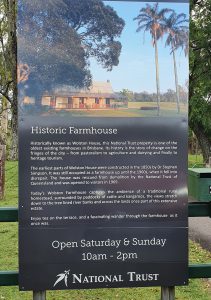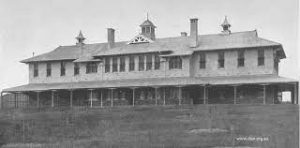Woogaroo – Wolston – Wacol – a long military history
For thousands of years before colonialisation, Aboriginal people lived in this area. There are no records of any campsites or ceremonial grounds at the site of the former Camp Columbia. According the Dr. Ray Kerkhove in his book “Aboriginal Campsites of Greater Brisbane”, there might have been a campsite in the Goodna area, at the Goupong Park above Goodna Creek, west of the former Rifle Range, mentioned below.
According to Aboriginal Elders the area of Camp Columbia was used for hunting all the way to the river, where of course the Aboriginal people also fished.

Since white settlers started to move into the area, the site under discussion has had an amazingly long law enforcement history, right from its beginnings in 1842 till today. It started with Dr Stephen Simpson who in 1841 became thew Colonial Surgeon. He temporarily moved into a cottage of the Female Factory at Eagle Farm. In 1842 he became the the Commissioner of Crown Lands, and after the military commander of the convict settlement left, also the Police Magistrate. He was the most senior government official in Brisbane until Wickham arrived a year later. Simpson established close to the spot where John Oxley ended his exploration of the Brisbane River in 1823, at a spot he called Termination Hill. The Boarder Police Station operated with 4 troopers and 6 convicts, manning a small slab hut and a lock-up. This was a strategic point as it was here where the convict road from Brisbane to Ipswich met with Brisbane River. Convicts also build here his residence what soon became known as Wolston House, which still stands here on the river.
Simpson soon extended his property to what today is the whole area of Wacol. After the British Troops were withdrawn from Australia, the Queensland Defence Force (QDF) was created in 1876. In 1884 a reserve was gazetted for them at Wolston for a long rifle range. However, the reserve was never used for this purpose.

Another related developments was that in 1865 the Woogaroo Lunatic Asylum was opened. The Superintend of the Asylum was also the Acting Police Magistrate for the district. It was situated on the land that previously was used for the Boarder Police Station. In the 1880s a range of military exercises were held at the Asylum. During that period the Superintendent was also the Captain of the QDF. Around 400 volunteers camped on the site during these exercises.
During WWI a considerable number of soldiers were admitted to the Asylum and in WWII it was also used by the US Army, however, they did establish their own hospital at Camp Columbia. Today the Asylum has grown into ‘The Park Center for Mental Health’.
Back a few decades to 1917 when a Wolston Soldiers Settlement was surveyed, for returning WWI soldiers. It consisted of 12 small farms, however not all blocks were sold. A few of these buildings were later incorporated in Camp Columbia.
In 1942 large parts of what was the previous Simpson property was required by the US Army for Camp Columbia. In 1944 the site was taken over by the Netherlands East Indie Government-in-Exile. After the war large parts of the site were taken over by the Australian Army and after their departure Corrective Services established several prisons on the site.
The name Wacol is believed to come from the railway workers, an abbreviation of the notorious weighbridge for coal. Notorious as it caused great delays for other traffic. The original name for the area was Woogaroo (named after the creek) and Wolston (named after the homestead of Dr Stephen Simpson from the 1850s). At the time the Americans arrived there were approx 20 families living in the area.
